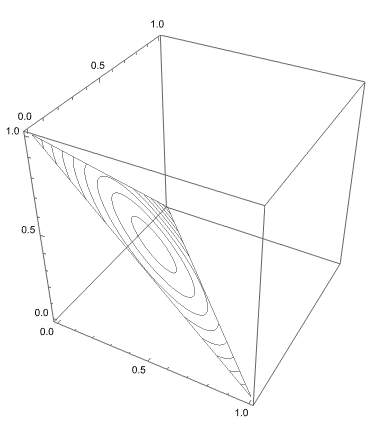I need to randomlyisotropically sample vectors in $\mathbb{R}^d$ of Euclidean norm $c$ such that components are positive and add up to 1. Any suggestions how to do this in Mathematica?
For $d=3$ this means sampling from one of the circular contours in
SliceContourPlot3D[Sqrt[x^2 + y^2 + z^2],
x + y + z == 1, {x, 0, 1}, {y, 0, 1}, {z, 0, 1}]
Things I tried
RandomPoint[ RegionIntersection[Sphere[{0, 0, 0}, .9], Simplex[IdentityMatrix[3]]]]-- returns unevaluated- Rejection sampling. Inefficient for $d=3$, completely impractical for higher values, I need $d=100$.
Code below is for debugging rejection sampling in $d=3$ case. It takes a sample of 3d points, projects onto $x_1+x_2+x_3=1$ plane, displays them along with the target region marked in gray. Will appreciate any suggestions on making an efficient sampler.
(* simplex visualization code from https://mathematica.stackexchange.com/a/139443/217 *)
visualize[points_, c_] := Module[{},
d = 3;
kk = Array[k, 6];
mat = Partition[kk, 2];
bb = Array[b, 3];
source = {{-1/Sqrt[2], 0}, {1/Sqrt[2], 0}, {0, Sqrt[3/2]}};
target = IdentityMatrix[3];
eqs = Table[mat . source[[i]] + bb == target[[i]], {i, 3}];
sol = First@Solve[eqs, kk~Join~bb];
{mat0, bb0} = {mat, bb} /. sol;
imat0 = PseudoInverse[mat0];
unmap[point_] := imat0 . (point - bb0);
expr = mat0 . {x, y} + bb0;
reg = ImplicitRegion[Reduce[Thread[expr > 0]], {x, y}];
regionPlot = RegionPlot[reg, PlotStyle -> None];
pointsPlot = ListPlot[unmap /@ points];
val = Sqrt[Total[expr^2]];
contourPlot =
ContourPlot[val == c, {x, y} \[Element] reg,
AspectRatio -> Automatic, PlotPoints -> 10,
ContourShading -> None,
ContourStyle -> Directive[Opacity[.3], Gray, Thickness[.02]]];
Show[regionPlot, contourPlot, pointsPlot]
];
points = RandomVariate[NormalDistribution[], {100, 3}];
visualize[points, .8]
Motivation is to get a diverse sampling of discrete distributions of given complexity. JimB's previous answer achieves some progress for the case when entropy is the complexity measure. This question corresponds to linear entropy as the complexity measure. Related question on math.SE.


